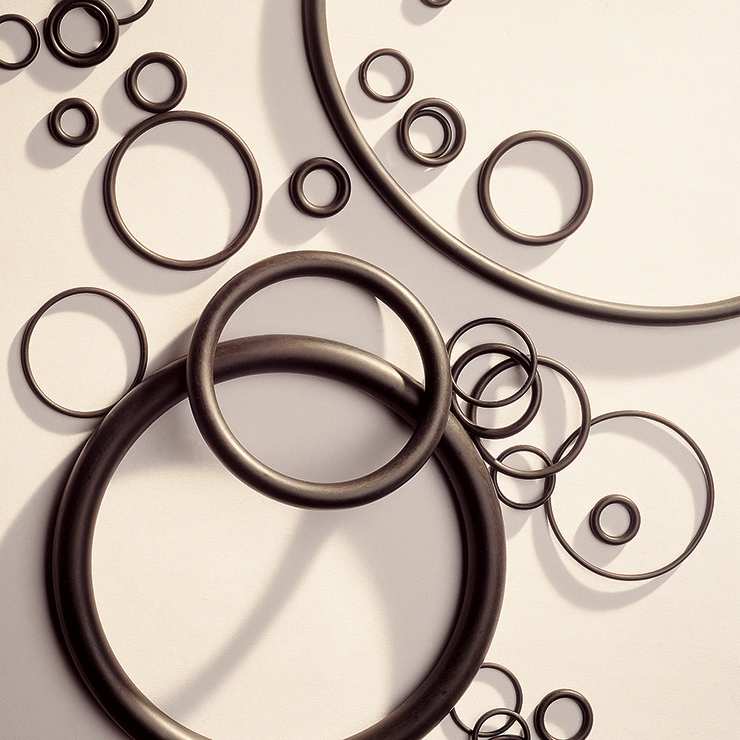Use stresses
Its ease of use and low cost have made the O-Ring one of the most widely used gaskets in modern day industry. For this reason, many compounds have been studied which can be adapted for the most diverse conditions of use. In this paragraph we analyse the principal chemical-physical stresses to which O-Rings are subjected. In order to be able to evaluate the quality of a particular compound's behaviour, with the use stresses assigned, it is necessary to fix some parameters which can be analysed. The O-Ring seal is linked to the elastic characteristics of the material, therefore all factors that may intervene and modify such properties influence the behaviour of the O-Ring. The coefficient of thermal expansion and gas permeability can also play an important role in the sealing effect and the duration of the gasket.
Compression Set
One of the principal parameters in the evaluation of O-Rings is without a doubt the 'Compression Set', or the permanent deformation of verifiable compression following its use. The Compression Set is defined as a percentage value of permanent deformation with respect to the original diameter of the ring, and is influenced by the operating conditions to which the O-Ring is subjected, in particular by all actions that modify the elasticity of the compound in a permanent manner. Different standards exist at national and international level for the evaluation of the Compression Set of the various compounds available. The principle on which they are based is the execution of a test with strain imposed on the samples and pre-arranged environmental conditions, to evaluate the spring back at the end of the test. The percentage value of the Compression Set is obtained with the following expression:
Cs = (hi – hf) / (hi – hc) %
Here, hi is the initial value of the sample's thickness, hc the value of the compressed sample's thickness and hf the final thickness after the spring back (figure 3.10).
Cs = (hi – hf) / (hi – hc) %
Here, hi is the initial value of the sample's thickness, hc the value of the compressed sample's thickness and hf the final thickness after the spring back (figure 3.10).
 Figure 3.10
Figure 3.10Thickness of the section of a random sample, before, during and after the Compression Set test
The main factor that influences the elastic behaviour of the elastomers is ageing, as this causes modifications to the molecular structure of the material and therefore a decline of its elastic properties.
The Compression Set value is linked to operating conditions. In order to have precise information regarding the quality of a particular compound it is therefore necessary to check it directly with tests that recreate pressure values, temperature and type of contact fluid, that are as close as possible to reality.
A good Compression Set value, a low percentage value, indicates a good duration over time for both static and dynamic seals. In the case of static applications, the loss of elasticity reduces the capacity of the O-Ring to absorb the pressure variations of the system without leaks. In dynamic seal applications, friction and the consequent increase in temperature of the compound can speed up ageing and therefore the worsening of the Compression Set (increase of the percentage value).
In figure 3.11, we show the behaviour of the Compression Set for O-Rings of 4 different compounds, subjected to compression tests with a variation of the nominal diameter of the ds section equal to 25%, on O-Ring with nominal diameter ds = 5.30 mm, for cycles lasting 70 hours at different temperatures.
The Compression Set value is linked to operating conditions. In order to have precise information regarding the quality of a particular compound it is therefore necessary to check it directly with tests that recreate pressure values, temperature and type of contact fluid, that are as close as possible to reality.
A good Compression Set value, a low percentage value, indicates a good duration over time for both static and dynamic seals. In the case of static applications, the loss of elasticity reduces the capacity of the O-Ring to absorb the pressure variations of the system without leaks. In dynamic seal applications, friction and the consequent increase in temperature of the compound can speed up ageing and therefore the worsening of the Compression Set (increase of the percentage value).
In figure 3.11, we show the behaviour of the Compression Set for O-Rings of 4 different compounds, subjected to compression tests with a variation of the nominal diameter of the ds section equal to 25%, on O-Ring with nominal diameter ds = 5.30 mm, for cycles lasting 70 hours at different temperatures.
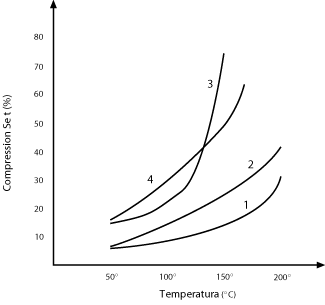 Figure 3.11
Figure 3.11The compounds tested are: curve 1) FPM, curve 2) MVQ, curve 3) ACM, curve 4) NBR.
The graph shows how the temperature, influencing the ageing of the material, also influences the Compression Set value, and how some compounds are more suitable than others for use at high temperatures.
The Compression Set value for a compound is not only linked to the operating conditions. In fact, by subjecting O-Rings with identical compounds but with different dimensions to compression tests with the same temperature conditions, it was possible to evaluate how some compounds present elastic behaviour linked not only to operating conditions, but also to the geometric form in which they are moulded. In the following figures, we show the results that we obtained by testing O-Rings of different compounds, with two different dimensions.
The Compression Set value for a compound is not only linked to the operating conditions. In fact, by subjecting O-Rings with identical compounds but with different dimensions to compression tests with the same temperature conditions, it was possible to evaluate how some compounds present elastic behaviour linked not only to operating conditions, but also to the geometric form in which they are moulded. In the following figures, we show the results that we obtained by testing O-Rings of different compounds, with two different dimensions.
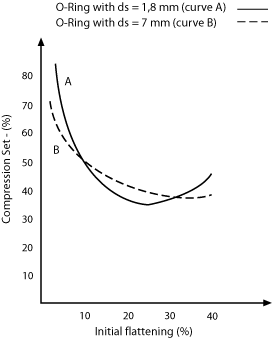 Figure 3.12
Figure 3.12NBR (acrylonitrile butadiene) with hardness 70° shore, curve A ds=1,8 mm , curve B ds=7 mm
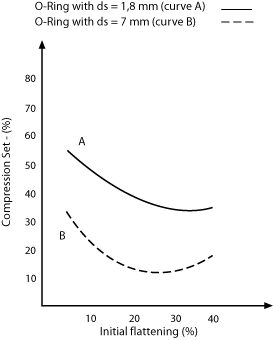 Figure 3.13
Figure 3.13MVQ (silicone) with hardness 70° shore, curve A ds=1,8 mm , curve B ds=7 mm
The test was carried out on the O-Rings applying different initial flattening to the various samples, maintaining a constant temperature for 70-hour test cycles.
The results obtained show how O-Rings with an MVQ compound are subject to a very high Compression Set value, but this value is not influenced in a noticeable way by the different dimensions of the tested samples.
The behaviour of O-Rings with an NBR compound is different, where the elasticity is influenced by the value of the diameter of the section.
The results obtained show how O-Rings with an MVQ compound are subject to a very high Compression Set value, but this value is not influenced in a noticeable way by the different dimensions of the tested samples.
The behaviour of O-Rings with an NBR compound is different, where the elasticity is influenced by the value of the diameter of the section.
The hardness of the compounds
If elasticity is the property that renders the compound suitable for sealing applications, the value of its hardness (that is the value of resistance opposed to penetration by harder objects) defines which stress situations it is suitable for.
In fact, the use of harder and softer compounds is strictly linked to the pressure values that are exercised on the element. Soft compounds exercise a good static sealing effect, easily adhering to the roughness of the seal surface, but they can be subject to extrusion if the pressure values are high. As well as this, in the presence of relative movement between the O-Ring and the seal surfaces (in the case of a dynamic seal), the friction generated by a soft compound is greater than that generated by a harder compound, and the consequent deterioration of the sealing properties turns out to be faster.
In fact, the use of harder and softer compounds is strictly linked to the pressure values that are exercised on the element. Soft compounds exercise a good static sealing effect, easily adhering to the roughness of the seal surface, but they can be subject to extrusion if the pressure values are high. As well as this, in the presence of relative movement between the O-Ring and the seal surfaces (in the case of a dynamic seal), the friction generated by a soft compound is greater than that generated by a harder compound, and the consequent deterioration of the sealing properties turns out to be faster.
Ageing
As was shown in the paragraph regarding the Compression Set, the ageing process of the elastomer has a great influence on the sealing capacities of the O-Rings. The term ageing indicates the loss of the elastomer's physical and chemical characteristics, and is caused by many external factors such as the temperature, mechanical actions or the atmosphere in contact with the elastomer.
With ageing, the molecular chains that make up the compound are modified and the links are modified, modifying as a consequence the behaviour of the material. The modification to the links starts from the external surface, exposed to external agents, and with time spreads deeper down.
Entering a little into detail, we can say that the characteristics of elastomers depend on the type of link that forms between the molecules that make them up and that to obtain particular links, chemical elements are added to the base material, called loads, which take part in the formation of molecular links, thus conferring the desired characteristics to the compound. In the following paragraphs, we will examine some work conditions and their effect on the O-Rings, remembering that in many situations, as well as the stresses directed on the compounds, they accelerate the ageing process, also in consideration of the fact that in real applications many of the stresses act in a concomitant manner, increasing the negative effects of the O-Ring's sealing capacity.
The ageing process of the material starts almost immediately, that is from the moment in which the O-Ring is realised and placed in contact with air and light. To remedy this difficulty, it is a good idea to maintain a thin layer of lubricant around the ring and only expose it to the light for the time necessary for the assembly phases.
With ageing, the molecular chains that make up the compound are modified and the links are modified, modifying as a consequence the behaviour of the material. The modification to the links starts from the external surface, exposed to external agents, and with time spreads deeper down.
Entering a little into detail, we can say that the characteristics of elastomers depend on the type of link that forms between the molecules that make them up and that to obtain particular links, chemical elements are added to the base material, called loads, which take part in the formation of molecular links, thus conferring the desired characteristics to the compound. In the following paragraphs, we will examine some work conditions and their effect on the O-Rings, remembering that in many situations, as well as the stresses directed on the compounds, they accelerate the ageing process, also in consideration of the fact that in real applications many of the stresses act in a concomitant manner, increasing the negative effects of the O-Ring's sealing capacity.
The ageing process of the material starts almost immediately, that is from the moment in which the O-Ring is realised and placed in contact with air and light. To remedy this difficulty, it is a good idea to maintain a thin layer of lubricant around the ring and only expose it to the light for the time necessary for the assembly phases.
Operating temperature
A very important element in the choice of an O-Ring is the temperature at which it must operate.
Elastomers have different reactions to the stresses of temperature, but in general a variation of the elasticity is derived from this. At low temperatures the compounds tend to lose elasticity, its capacity to carry out seals thus diminishing. At high temperatures the material tends to become more fluid, better adhering to the surfaces, but proving to be more susceptible to extrusion due to the effect of the pressure, or movement in the case of a dynamic seal.
Another cause of O-ring malfunction can be linked to the coefficient of thermal expansion of the compounds, which is usually very different from that of the material that makes up its installation seat. This means that the expansions and contractions of materials due to sudden changes of temperature can be very different. In the case of high temperatures, the compound tends to expand and occupy the whole seat, causing an undesired increase of friction in dynamic applications.
In the case of low temperatures, the contraction of the material leads to a reduction of the flattening of the section diameter, which can diminish until the seal is compromised. In figure 3.14, we show an example of the effect of temperature on an O-Ring with an NBR compound, with a degree of hardness equal to 80° shore, subjected to tests for the evaluation of the Compression Set and hardness at various temperatures.
Elastomers have different reactions to the stresses of temperature, but in general a variation of the elasticity is derived from this. At low temperatures the compounds tend to lose elasticity, its capacity to carry out seals thus diminishing. At high temperatures the material tends to become more fluid, better adhering to the surfaces, but proving to be more susceptible to extrusion due to the effect of the pressure, or movement in the case of a dynamic seal.
Another cause of O-ring malfunction can be linked to the coefficient of thermal expansion of the compounds, which is usually very different from that of the material that makes up its installation seat. This means that the expansions and contractions of materials due to sudden changes of temperature can be very different. In the case of high temperatures, the compound tends to expand and occupy the whole seat, causing an undesired increase of friction in dynamic applications.
In the case of low temperatures, the contraction of the material leads to a reduction of the flattening of the section diameter, which can diminish until the seal is compromised. In figure 3.14, we show an example of the effect of temperature on an O-Ring with an NBR compound, with a degree of hardness equal to 80° shore, subjected to tests for the evaluation of the Compression Set and hardness at various temperatures.
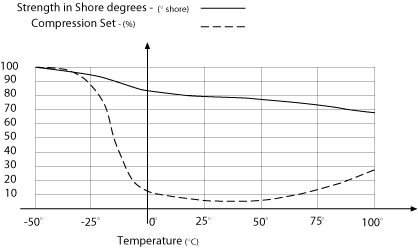 Figure 3.14
Figure 3.14
For these reasons, it is important when choosing an O-Ring to consider the working temperature and design the seats, carefully evaluating the volumetric variations that such temperatures involve.
Contact fluids
The ease of use of O-Rings is such that they find applications in the most diverse sectors in which a seal may be required.
For this reason, the O-Ring may find itself in contact with liquids, vapours and gases of the most diverse natures, and its behaviour is influenced to the degree by which such fluids interact with the compound that make it up. On contact with a fluid, the compound may react in different ways.
The fluid may penetrate in the compound with the result of increasing its volume:
The variation of the chemical-physical characteristics of the O-Ring compound due to the action of the fluids may lead to the loss of the seal capacities; the value of the operating temperature has a great influence on the aggressive behaviour of the fluids.
It is therefore of fundamental importance to consider the fluids that come into contact with the O-Ring to be able to find the compound that best resists their aggression.
The standard ISO 6072 defines the Compatibility Index (ECI), in order to be able to compare the behaviour of various compounds in contact with the fluids. The ECI parameters establish, in a scale of values, the volumetric variation to which an elastomer in contact with a fluid is subjected.
Our technical office is able to offer advice regarding the best compound to use depending on the fluid to contain.
For this reason, the O-Ring may find itself in contact with liquids, vapours and gases of the most diverse natures, and its behaviour is influenced to the degree by which such fluids interact with the compound that make it up. On contact with a fluid, the compound may react in different ways.
The fluid may penetrate in the compound with the result of increasing its volume:
- there may be a modification to the elastic behaviour linked to the presence within the compound's molecular structure of pockets with a different elastic behaviour;
- there may be a modification to the molecular structure with the breaking of the old links and the crea- tion of new links with the components that have penetrated inside the compound.
- the fluid acts as a solvent on some components of the compound, breaking up the links and expelling such dissolved substances.
- some components of the compound are dissolved and expelled, and substituted with an equal quan- tity of fluid that may link itself to the molecules of the compound thus modifying them, or remain insi- de it forming pockets.
The variation of the chemical-physical characteristics of the O-Ring compound due to the action of the fluids may lead to the loss of the seal capacities; the value of the operating temperature has a great influence on the aggressive behaviour of the fluids.
It is therefore of fundamental importance to consider the fluids that come into contact with the O-Ring to be able to find the compound that best resists their aggression.
The standard ISO 6072 defines the Compatibility Index (ECI), in order to be able to compare the behaviour of various compounds in contact with the fluids. The ECI parameters establish, in a scale of values, the volumetric variation to which an elastomer in contact with a fluid is subjected.
Our technical office is able to offer advice regarding the best compound to use depending on the fluid to contain.
Mechanical stresses
In this paragraph we will examine some mechanical stresses to which the O-Ring is subjected during its use, and the possible effect that such stresses may have on the seal capacities of the connection.
Compression forces
As we have stressed several times, the O-Ring seal is obtained thanks to the compression of the ring in a seat machined for the purpose.
The flattening force combined with other factors that weaken the compound can cause the breakage of the molecular links present, with consequences regarding the characteristics of the O-Ring. From the breakage of the links, a variation of the elasticity of the elastomer may be derived and there may also be different behaviour on contact with the fluids present in the system as the molecular structure has been modified. Premature ageing of the compound may also derive from the breakage of the molecular structure.
The flattening force combined with other factors that weaken the compound can cause the breakage of the molecular links present, with consequences regarding the characteristics of the O-Ring. From the breakage of the links, a variation of the elasticity of the elastomer may be derived and there may also be different behaviour on contact with the fluids present in the system as the molecular structure has been modified. Premature ageing of the compound may also derive from the breakage of the molecular structure.
Friction in dynamic applications
In dynamic seal applications, a very important factor that influences the quality of the seal and gasket, is the force of friction. The exact evaluation of the phenomenon is very complex, as there are many factors in play that have reciprocal influence and are difficult to check. Keeping the friction low between the moving parts allows the equipment to function in a better way, but may signify an increase in leaks caused by the reduction of the O-Ring's adherence to the seal surfaces.
In the first instance we can say that the value of the coefficient of friction between two elements such as the O-Ring and the seal surface is not constant, but depends on the velocity. In figure 3.15 we show the approximate progress of the coefficient of friction in relation to the movement velocity (this progress can be verified in most cases).
In the first instance we can say that the value of the coefficient of friction between two elements such as the O-Ring and the seal surface is not constant, but depends on the velocity. In figure 3.15 we show the approximate progress of the coefficient of friction in relation to the movement velocity (this progress can be verified in most cases).
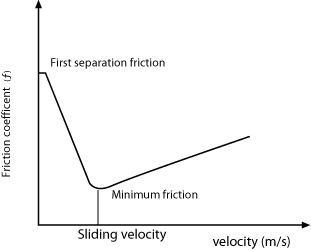 Figure 3.15
Figure 3.15
The first separation friction is the force that one must overcome in order to put a body in motion, and such a force is greater than the one opposed to the movement. On the increase of velocity after the separation, the coefficient of friction value ƒ diminishes until the velocity reaches the limit value of the sliding velocity, velocity at which the value of ƒ is lowest. At velocities higher than the sliding velocity, the coefficient of friction starts to increase again.
Whilst aintaining the approximate progress shown in figure 3.15, the coefficient of friction value ƒ may vary a great deal in relation to the operating conditions. We refer to the hardness of the O-Ring compound, the preloading pressure that pushes it towards the seal walls and the presence of lubricant. In particular, the function of lubricant can be carried out by fluid present in the circuit, which forming a thin film between wall and gasket, contributes towards lowering the coefficient of friction.
The presence of roughness and imperfections on the seal surface may increase the abrasive effect, but may also allow the formation of fluid pockets and thus maintain good lubrication. The prevailing of one of these two effects is linked to the dimensions of the irregularities and the hardness of the compound.
Dynamic applications can be divided into two main types according to whether it is a liquid or gas seal.
Whilst aintaining the approximate progress shown in figure 3.15, the coefficient of friction value ƒ may vary a great deal in relation to the operating conditions. We refer to the hardness of the O-Ring compound, the preloading pressure that pushes it towards the seal walls and the presence of lubricant. In particular, the function of lubricant can be carried out by fluid present in the circuit, which forming a thin film between wall and gasket, contributes towards lowering the coefficient of friction.
The presence of roughness and imperfections on the seal surface may increase the abrasive effect, but may also allow the formation of fluid pockets and thus maintain good lubrication. The prevailing of one of these two effects is linked to the dimensions of the irregularities and the hardness of the compound.
Dynamic applications can be divided into two main types according to whether it is a liquid or gas seal.
a) Liquid dynamic seal
Analysing this application, we can observe that the O-Ring adheres with a certain force to the seal surfaces, that this force is linked to the volume of the ring in relation to the dimensions of the slot, and to the pressure exercised by the fluid. A force of friction depending on these parameters opposes the movement between the parts. The liquid may, as we have already seen, form a lubricating film that protects the O-Ring.
The presence of friction generates a certain quantity of heat that can cause system variations:
Additives can be added to the liquids of the circuit in order to limit the damaging effects of friction.
Reliable information regarding behaviour during operation can only be obtained by subjecting the O-Rings to tests.
The presence of friction generates a certain quantity of heat that can cause system variations:
- the heat can cause a variation to the volume of the O-Ring and therefore a variation to the force of adhesion to the walls of the seat;
- when the liquid heats up its viscosity may vary and impede the formation of the lubricating film with the consequent fast abrasion of the O-Ring;
- the elasticity of the O-Ring that is in contact with the seal surface may vary, facilitating extrusion;
- the aggressiveness of the liquid may increase towards the compound and cause irreversible alterations.
Additives can be added to the liquids of the circuit in order to limit the damaging effects of friction.
Reliable information regarding behaviour during operation can only be obtained by subjecting the O-Rings to tests.
b) Gas dynamic seal
The dynamic seal in the presence of gas under pressure presents problems similar to those seen for the applications with liquids, but differs in a particular way due to the absence of a fluid that can act as a lubricant. In particular applications, such as pneumatic circuit applications, a method can be used to overcome this problem. Air can be utilised in which a certain quantity of lubricating oil is present in suspension that deposits itself on the O-Ring thus reducing friction. In any case self-lubricating compounds can be used to diminish the coefficient of friction. The most evident problem in such a type of application remains wear of the ring due to friction; the imperfections of the seal surfaces have a more damaging effect due to the scarce quantity of lubricant that manages to find its way between the O-Ring and the seal surface.
Another factor that influences friction in pneumatic applications and more generally with gas, is the gas permeability to which the compounds are subjected. In fact, all elastomers are gas permeable in varying degrees and this leads to the forming of bubbles within the compound. The presence of such bubbles, as well as causing a variation in the volume of the ring and therefore increasing the force with which it presses against the seal walls, weakens the resistance to superficial abrasion, rendering the composition of the compound uneven. As well, obsessive heating linked to the friction can cause the explosion of these bubbles and the deterioration of the O-Ring.
In the following paragraph we will briefly look at the origins and effects of gas permeability.
Another factor that influences friction in pneumatic applications and more generally with gas, is the gas permeability to which the compounds are subjected. In fact, all elastomers are gas permeable in varying degrees and this leads to the forming of bubbles within the compound. The presence of such bubbles, as well as causing a variation in the volume of the ring and therefore increasing the force with which it presses against the seal walls, weakens the resistance to superficial abrasion, rendering the composition of the compound uneven. As well, obsessive heating linked to the friction can cause the explosion of these bubbles and the deterioration of the O-Ring.
In the following paragraph we will briefly look at the origins and effects of gas permeability.
Gas permeability
In gas seal applications, the O-Rings form a barrier between two areas under different pressures.
The characteristics of the elastomers render them gas permeable, and this permeability depends on the type of gas, the operating temperature and the pressure that the gas exercises. The permeability can cause a loss of gas, which passes from the area under greater pressure to the area under lower pressure, through the elastomer. A certain quantity of gas stays inside the compound forming bubbles that have an effect on the elastic behaviour of the ring. Also, the direct contact of the gas with the external surface of the O-Ring can speed up the ageing process of the compound.
It has been proven that a layer of lubricating oil on the surface of the O-Ring, as well as preserving it from premature ageing, diminishes the permeability of the material, consequently diminishing the leaks of the system.
In Table 3.2 we show the coefficients of permeability to certain gases for the compounds most commonly used in the production of O-Rings.
For more information regarding the behaviour of O-Rings in the presence of various gases, please contact our technical office.
The characteristics of the elastomers render them gas permeable, and this permeability depends on the type of gas, the operating temperature and the pressure that the gas exercises. The permeability can cause a loss of gas, which passes from the area under greater pressure to the area under lower pressure, through the elastomer. A certain quantity of gas stays inside the compound forming bubbles that have an effect on the elastic behaviour of the ring. Also, the direct contact of the gas with the external surface of the O-Ring can speed up the ageing process of the compound.
It has been proven that a layer of lubricating oil on the surface of the O-Ring, as well as preserving it from premature ageing, diminishes the permeability of the material, consequently diminishing the leaks of the system.
In Table 3.2 we show the coefficients of permeability to certain gases for the compounds most commonly used in the production of O-Rings.
For more information regarding the behaviour of O-Rings in the presence of various gases, please contact our technical office.
Technical sheets
